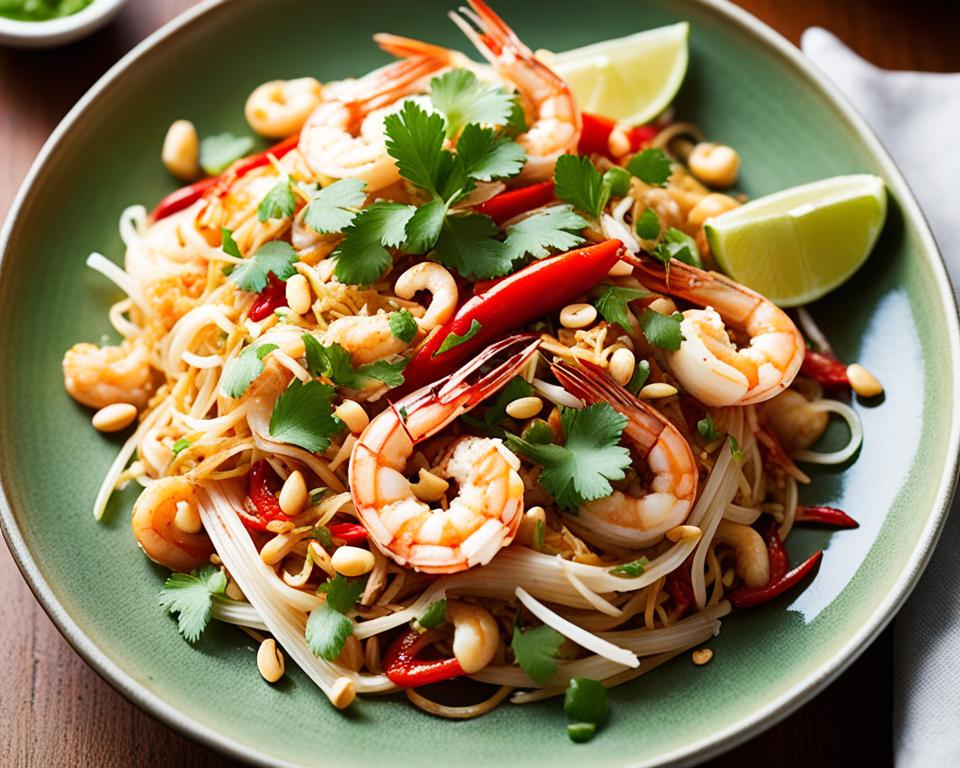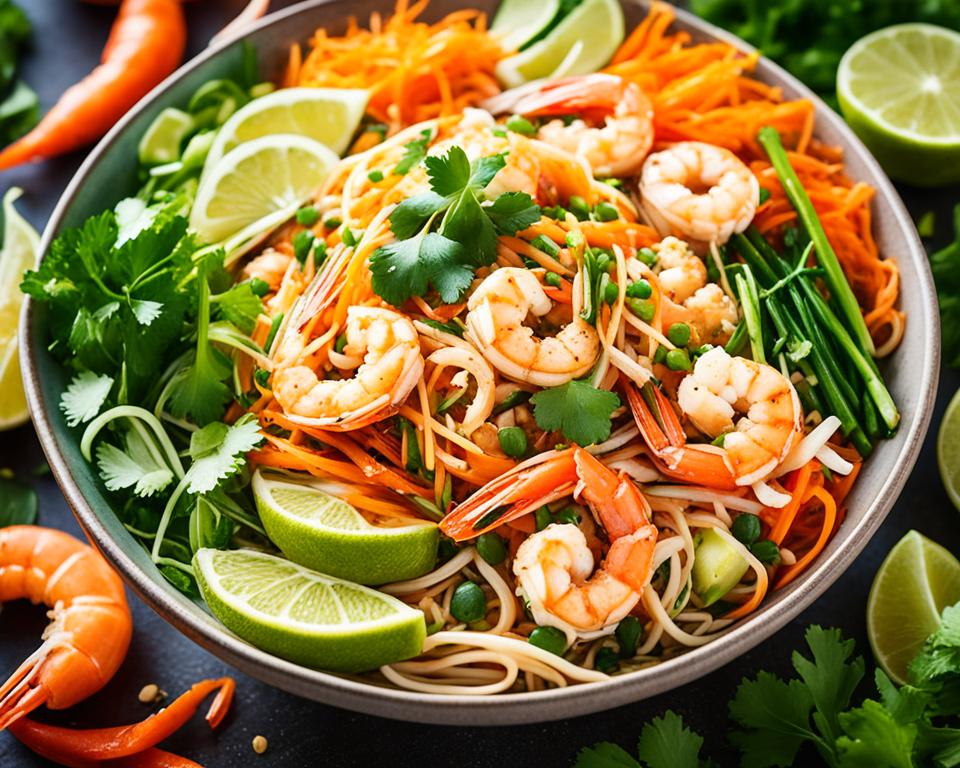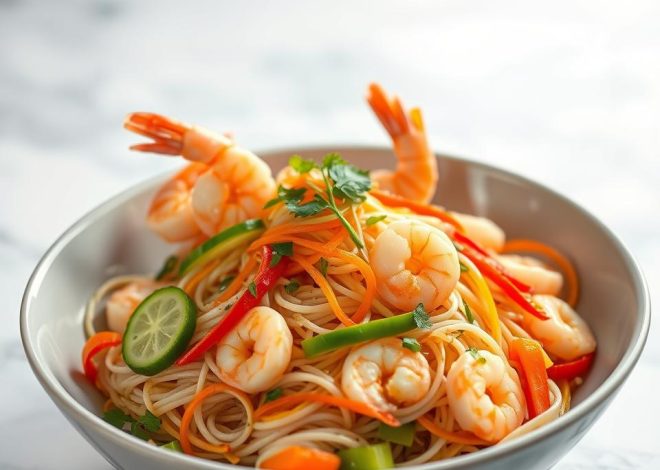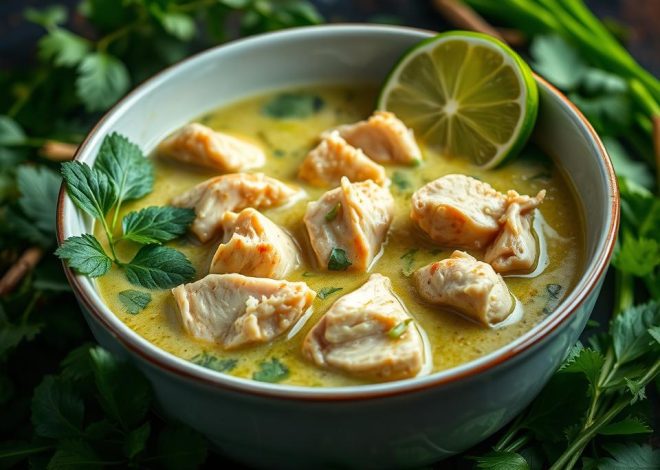
Authentic Pad Thai with Fresh Shrimp Recipe
Step into Thailand with a taste of this authentic Pad Thai. Garnished with fresh shrimp, this dish is a Thai street food favorite. It combines sweet, sour, and savory flavors perfectly. Now, you can make it at home and enjoy the true essence of Thailand.
The dish Pad Thai is loved worldwide for its bold taste and various flavors. Adding fresh shrimp makes it even better, giving it a unique sweetness. From beginners to expert cooks, everyone will love this recipe. It’ll feel like you’re in Thailand, enjoying their vibrant cuisine.
Read more interesting information at ::i-pasta
The Origins of Pad Thai
Pad Thai is more than just a meal; it’s a symbol of Thailand’s lively food culture. This noodle dish shows how different influences shaped Thai cuisine over the years.
History and Cultural Significance
In the late 19th century, Thailand was called Siam. At that time, changes in society and economy pushed for a new, nutritious meal. This led to the creation of Pad Thai, which became a common and affordable food.
The recipe for Pad Thai got its start from Chinese immigrants. They brought with them the use of rice noodles and stir-frying. Ingredients like bean sprouts and peanuts joined in, mixing both Thai and Chinese flavors.
Pad Thai quickly became a favorite food, not only in Thailand but around the globe. It stands out with its bright colors, rich taste, and lively texture. People from all over love its unique blend of flavors and textures.
“Pad Thai is a culinary ambassador, introducing the world to the richness and complexity of authentic Thai recipes and noodle dishes.”
Pad Thai represents Thailand’s food culture, old and new. It shows how the country keeps its traditions alive while trying new things. This dish is a favorite that celebrates Thailand’s past and present in every bite.
Why Fresh Shrimp Makes a Difference
For an authentic Pad Thai, the right shrimp is key. While it’s easy to pick frozen, fresh shrimp takes this Thai favorite to another level. It adds unique flavors and textures that you can’t find in frozen types.
The key is in how fresh and high-quality the shrimp is. Fresh shrimp is softer, more juicy, and tastes sweeter than frozen. It brings out the best in Pad Thai, mixing well with its sauce’s tangy, salty, and lightly sweet notes.
Fresh shrimp has a much better feel when you stir-fry it, too. It stays firm and succulent, making your dish more satisfying. Frozen shrimp can get tough or watery, which doesn’t do your Pad Thai any favors.
Choosing fresh shrimp isn’t just about making a better dish. It also respects Thailand’s food culture. Pad Thai represents the country’s varied taste in every bite. Using the best, freshest shrimp makes your pad thai with shrimp top-notch. It gives your dinner guests a taste of a truly authentic Thai meal.
“The secret to a truly exceptional Pad Thai lies in the quality of the shrimp. Fresh, succulent shrimp elevate this dish to a level of culinary perfection that simply cannot be achieved with frozen alternatives.”
Ingredients for Authentic Pad Thai with Fresh Shrimp
Making real Pad Thai with shrimp needs some special ingredients. Each one is key in bringing out the delicious tastes and textures of this favorite Thai dish. We will look at these must-have items and see what you can swap for if you have special food needs.
Essential Ingredients and Substitutions
Rice noodles are the heart of Pad Thai. They are thin and flat, giving the dish a chewy feel. If you can’t have gluten, try using rice stick noodles or vermicelli noodles instead.
The fresh shrimp brings an important juicy and tasty part to Pad Thai. But, if you don’t eat meat, you can swap shrimp with tofu, tempeh, or mushrooms.
- Rice noodles or rice stick noodles for a gluten-free option
- Fresh shrimp or tofu, tempeh, or mushrooms for a vegetarian/vegan alternative
- Tamarind paste for a authentic tangy flavor
- Fish sauce or soy sauce for a savory umami note
- Palm sugar or brown sugar for sweetness
- Eggs or a vegan egg substitute
- Bean sprouts, chives, and crushed peanuts for garnish
Other must-haves in Pad Thai are tamarind paste for a tangy kick, plus fish sauce or soy sauce for a salty taste. You also need palm sugar or brown sugar for some sweetness. Don’t forget the eggs or a vegan egg substitute. Usually, we top the dish with bean sprouts, chives, and crushed peanuts for extra texture and taste.
With these ingredients, you’re set to make an authentic, tasty Pad Thai with shrimp. It’s a great way to honor Thailand’s food culture. If you need to change some things because of your diet, understanding what each part does will help you keep the dish’s true flavors.
Preparing the Pad Thai Noodles
The first important step in making Pad Thai is getting the noodles right. These rice noodles are thin and soft. The way you cook them is key to the dish’s success. They should be just right: not too soft or too tough, but with a bit of bounce.
To prepare Pad Thai noodles, start by soaking them in hot water. This makes them soft and ready to absorb the sauce. The soaking time changes based on the noodle’s thickness. Usually, you’ll soak them for 30 minutes to an hour.
- Boil water, then take it off the heat. Add in the noodles and let them soak for 30-60 minutes. They should be soft but still have a slight chew.
- After soaking, drain the noodles. Rinse them with cold water to keep them from cooking further. This keeps their shape and texture.
- Heat oil in a wok or skillet on high. Add the noodles and stir-fry for 2-3 minutes, until warmed up and turning golden.
- Now, you can add in the rest: shrimp, eggs, bean sprouts, and sauce. Keep stir-frying until everything mixes well and the noodles are fully cooked.
With these steps, your Pad Thai noodles will be spot on. They’ll be a perfect match for the sauce’s sweet, sour, and savory tastes. Your pad thai noodles will be just how you want them: soft, but not falling apart.
“The secret to great Pad Thai lies in the noodles. Get them right, and the rest will follow.”
Pad Thai with Fresh Shrimp Cooking Techniques
To make a great Pad Thai with fresh shrimp, learning to stir-fry well is key. It’s crucial to get the right texture by knowing how to stir-fry. This method will take your Pad Thai to the next level.
Stir-Frying Secrets for Perfect Texture
The main goal in a Pad Thai dish is getting the noodles and shrimp just right. They should be firm, yet tender, and have a perfect mix of flavors. The first step is to make your wok really hot before adding any oil. This hot wok will quickly sear the shrimp, keeping them moist and tasty.
- Toss the shrimp in the hot oil, stirring constantly to prevent overcooking and maintain their tender texture.
- Introduce the Pad Thai noodles and continue to stir-fry, ensuring the noodles are well-coated in the aromatic oil and absorb the flavors.
- Add the remaining ingredients, such as bean sprouts, chives, and the signature Pad Thai sauce, and stir-fry until the noodles are al dente and the shrimp are cooked through.
- The key to perfect texture is to avoid overcrowding the wok and maintain a high heat throughout the stir-frying process.
Learning these pad thai cooking techniques will help you create the perfect stir-fry recipes. Your Pad Thai with fresh shrimp will be a standout asian recipes dish.
| Technique | Purpose |
|---|---|
| High Heat Stir-Frying | Sears the shrimp and noodles, locking in flavor and maintaining tender texture |
| Constant Stirring | Ensures even cooking and prevents overcrowding for the perfect seafood recipes and shrimp dishes |
| Balanced Ingredient Addition | Allows the noodles, shrimp, and sauce to come together seamlessly |
“The secret to a perfect Pad Thai lies in the mastery of the stir-fry – a dance of heat, movement, and the harmonious blending of flavors.”
Balancing Flavors in Pad Thai
The perfect pad thai mixes sweet, sour, salty, and umami notes just right. It’s a cherished Thai dish that balances these flavors to bring a delightful experience. This mix of tastes really surprises and delights your taste buds.
Sweet, Sour, Salty, and Umami
To get pad thai right, you have to know each flavor’s role. Sweetness can come from palm sugar or tamarind, making it tasty against lime juice or tamarind’s sourness. Adding a pinch of salt from fish sauce or soy sauce boosts the dish’s overall savoriness. And for that deep, rich taste, umami from dried shrimp or cured radish is essential.
Getting the balance of these four tastes right is what makes great pad thai. Chefs who can adjust these elements make a pad thai that’s both gratifying and true to Thai cuisine.
| Flavor | Contribution to Pad Thai | Key Ingredients |
|---|---|---|
| Sweet | Provides a counterpoint to the sour and salty flavors | Palm sugar, tamarind |
| Sour | Adds brightness and freshness to the dish | Lime juice, tamarind |
| Salty | Enhances the overall savory profile | Fish sauce, soy sauce |
| Umami | Adds depth and complexity to the flavor profile | Dried shrimp, cured radish |
Knowing how to balance flavors is key for anyone making authentic pad thai. This applies whether you’re just starting or you’re a seasoned chef. It’s what makes your pad thai really stand out.

Garnishing and Plating Pad Thai
Make your pad thai look amazing by adding fresh shrimp. This step is key to making a dish that looks like something from a restaurant. Garnishing and plating turn a simple stir-fry into a work of art that excites the eyes and the stomach.
Start by placing the pad thai noodles you just cooked on a dish. Make sure they’re spread out evenly. Then, put the shrimp on top so their bright colors stand out next to the noodles. Add various fresh herbs and veggies as garnish,
- Freshly chopped cilantro
- Thinly sliced green onions
- Crisp bean sprouts
- Wedges of fresh lime
- Crushed roasted peanuts
These additions make the pad thai look and taste better. Like adding a burst of flavor and different textures. Place the garnishes in a way that looks good, using balance or a neat chaos.
To make it even fancier, add some sriracha or sweet chili sauce. You can make a pretty design on top with it. Besides being colorful, it lets people adjust the spice to what they like.
“The first bite is with the eye, and a visually stunning pad thai with fresh shrimp can elevate the entire dining experience.”
Always remember, making a great pad thai isn’t just about the taste. It’s also about how it looks. Balancing flavors, textures, and colors is key. A little creativity and careful work can turn your pad thai into a culinary masterpiece.
Vegetarian and Vegan Pad Thai Options
Thailand’s beloved dish, pad thai, goes beyond shrimp. Its adaptable nature welcomes vegetarian or vegan twists delightfully. You can make noodle dishes for all diets, including gluten-free recipes and healthy recipes.
Protein-Packed Vegetarian Pad Thai
Tofu stands as a star in vegetarian diets, including in pad thai. When cooked right, tofu can be just as good as shrimp. This vegetarian pad thai comes with bean sprouts, peanuts, and a perfect mix of flavors. It’s a tasty and filling choice.
Vibrant Vegan Pad Thai
In vegan pad thai, try plant-based proteins like tempeh or mushrooms. Add bright vegetables for color and crunch. Use gluten-free noodles and vegan sauce to keep it healthy and satisfying.
| Ingredient | Vegetarian Pad Thai | Vegan Pad Thai |
|---|---|---|
| Protein | Firm Tofu | Tempeh, Mushrooms |
| Noodles | Rice Noodles | Gluten-Free Rice Noodles |
| Vegetables | Bean Sprouts, Carrots, Scallions | Bell Peppers, Bean Sprouts, Carrots |
| Sauce | Tamarind, Fish Sauce (vegan substitute) | Tamarind, Soy Sauce, Maple Syrup |
| Garnish | Crushed Peanuts | Crushed Peanuts, Lime Wedges |
With vegetarian and vegan twists, you can savor great pad thai flavors. From tofu to other plant-based proteins, *there’s a lot to explore. Enjoy a bowl of Thai noodle dish that suits your diet.
“Pad thai is a dish that transcends boundaries, allowing everyone to savor its deliciousness, regardless of their dietary choices.”
Pairing Pad Thai with Fresh Shrimp
Adding fresh shrimp to your Pad Thai takes the meal up a notch. This addition changes the game. Pair it right with drinks and sides to make every bite perfect. The blend of sweet, sour, and savory will dance on your taste buds.
Complementary Beverages and Side Dishes
Fresh shrimp in Pad Thai means you need beverages that refresh. Thai iced tea is a top pick. Its dark tea, condensed milk, and spice mix are a classic match for the dish. Or try a fun twist with a lager or a fruity white wine.
Side dishes can amplify your Pad Thai. A zesty green salad cleans your palate. Steamed or stir-fried veggies like broccoli, carrots, or bok choy bring nutrition and variety. They are perfect alongside the main dish.
| Beverage Pairing | Side Dish Pairing |
|---|---|
| Thai Iced Tea | Green Salad with Ginger Dressing |
| Crisp Lager | Stir-Fried Broccoli and Carrots |
| Light, Fruity White Wine | Steamed Bok Choy |
Pair your Pad Thai with fresh shrimp thoughtfully. Match it with the right drinks and sides to bring out the best in each bite. This way, you celebrate the joys of Thai cuisine.
“Pairing the right beverages and sides with Pad Thai is like orchestrating a symphony of flavors – each element enhancing and elevating the other.”
Storing and Reheating Leftovers
Eating the yummy pad thai leftovers you made from a Thai cuisine night makes every bite memorable. But, you must store and reheat your noodle dishes the right way. This keeps your pad thai with fresh shrimp tasting as good as day one.
Storing Pad Thai Leftovers
Follow these steps to keep your pad thai leftovers safe and tasty:
- Put the noodle dish in an airtight container or a resealable bag.
- Make sure the cooked shrimp is mixed well with the pad thai.
- Get the leftovers in the fridge within 2 hours after cooking.
- When stored right, pad thai leftovers stay good for 3-4 days in the fridge.
Reheating Pad Thai Leftovers
Ready to enjoy your pad thai leftovers again? Here’s how to warm them up:
- Use a microwave-safe dish to heat the pad thai in 30-second bursts, stirring often.
- You can also use a skillet on medium heat. Add a little water or broth to keep the noodles from drying out.
- Don’t reheat the pad thai in the oven. It might dry out the noodles or overcook the dish.
It’s key to follow food storage and food safety tips when enjoying leftover pad thai. This way, you can enjoy it safely and deliciously.
Pad Thai with Fresh Shrimp Variations
Pad Thai with fresh shrimp is a favorite in Thai cuisine. It has many different types, depending on where you are. Each one brings something special to the table. In this versatility, you can find new tastes you’ll love.
Regional Twists on Pad Thai with Fresh Shrimp
Across Thailand, Pad Thai changes in exciting ways. The north might use peanuts and chili, while the south adds a lot of seafood. If you go central, it can be sweeter with palm sugar. This journey through the different versions opens your eyes to the wonder of Thai food.
Personal Adaptations of Pad Thai with Fresh Shrimp
On top of regional flavors, Pad Thai can be customized. Maybe you love it savory, or perhaps you’re into sweet versions. You can also get creative. Add things like crispy shallots or roasted peanuts. This lets you make Pad Thai just the way you like it.
| Pad Thai Variation | Distinctive Characteristics |
|---|---|
| Northern Thai Pad Thai | Peanuts, chili, and a slightly more savory profile |
| Southern Thai Pad Thai | Abundant seafood, including fresh shrimp, for a briny twist |
| Central Thai Pad Thai | Sweeter notes from the addition of palm sugar |
| Personalized Pad Thai | Customized with unique ingredients like crispy shallots or roasted peanuts |
Exploring Pad Thai with fresh shrimp opens the door to a world of flavors. You can go for a regional type or make one that’s all your own. This dish is all about making it perfect for you.
Nutritional Benefits of Pad Thai with Fresh Shrimp
Pad Thai is a favorite among many for good reason. It’s not only tasty but also healthy, especially with fresh shrimp. This meal has a mix of carbs, proteins, vitamins, and minerals for a balanced diet.
Pad Thai with shrimp is packed with protein, thanks to the shrimp. Shrimp is a great lean protein. It gives you amino acids you need for strong muscles. So, it’s perfect for anyone who wants to eat well and stay active.
Shrimp also brings lots of vitamin B12. This vitamin is key for healthy blood and brain. Shrimp is high in selenium too, which helps your body fight off damage and keeps your immune system strong.
The noodles in Pad Thai are usually rice, and that means they’re gluten-free. This is great news for those who can’t eat gluten. It gives them a delicious and nutritious meal choice.
Potential Health Benefits of Pad Thai with Fresh Shrimp
Eating Pad Thai with shrimp is good for your health. Shrimp is full of omega-3 fatty acids, which are great for your heart and reduce inflammation. This, along with the veggies and noodles, gives you a balanced bite that boosts your wellness.
| Nutrient | Amount per Serving | % Daily Value |
|---|---|---|
| Calories | 400 kcal | 20% |
| Protein | 22 g | 44% |
| Carbohydrates | 50 g | 17% |
| Fiber | 4 g | 16% |
| Vitamin B12 | 2.4 mcg | 100% |
| Selenium | 47 mcg | 85% |
| Omega-3 Fatty Acids | 300 mg | N/A |
If you want a meal that’s both tasty and nutritious, try Pad Thai with fresh shrimp. It’s a top choice for those looking to eat well. You’ll enjoy the dish while getting the health benefits of seafood and shrimp.

Making Pad Thai with Fresh Shrimp at Home
Making your own Pad Thai with fresh shrimp at home can be quite satisfying. With a few tips, anyone can capture the true essence of this popular Thai dish. It’s about getting the flavors and textures just right in your own kitchen.
Tips for Beginners and Experienced Cooks
If you’re new to cooking Pad Thai, first, gather the core ingredients. You’ll need things like fresh rice noodles, tamarind paste, fish sauce, and palm sugar. Learn how to properly soften and stir-fry the noodles. This way, they end up with the right chewy texture.
More skilled cooks might want to try some new things. For example, you could add Thai chili for extra kick. Or, swap the shrimp out for chicken or tofu. It’s all about making Pad Thai your way.
No matter your level, making great Pad Thai with fresh shrimp is about the ingredients and timing. You must also get the sweet, sour, and salty balance just right. By focusing on these details, everyone can become a Pad Thai expert. This dish will take your taste buds on a journey to the lively markets of Thailand.


